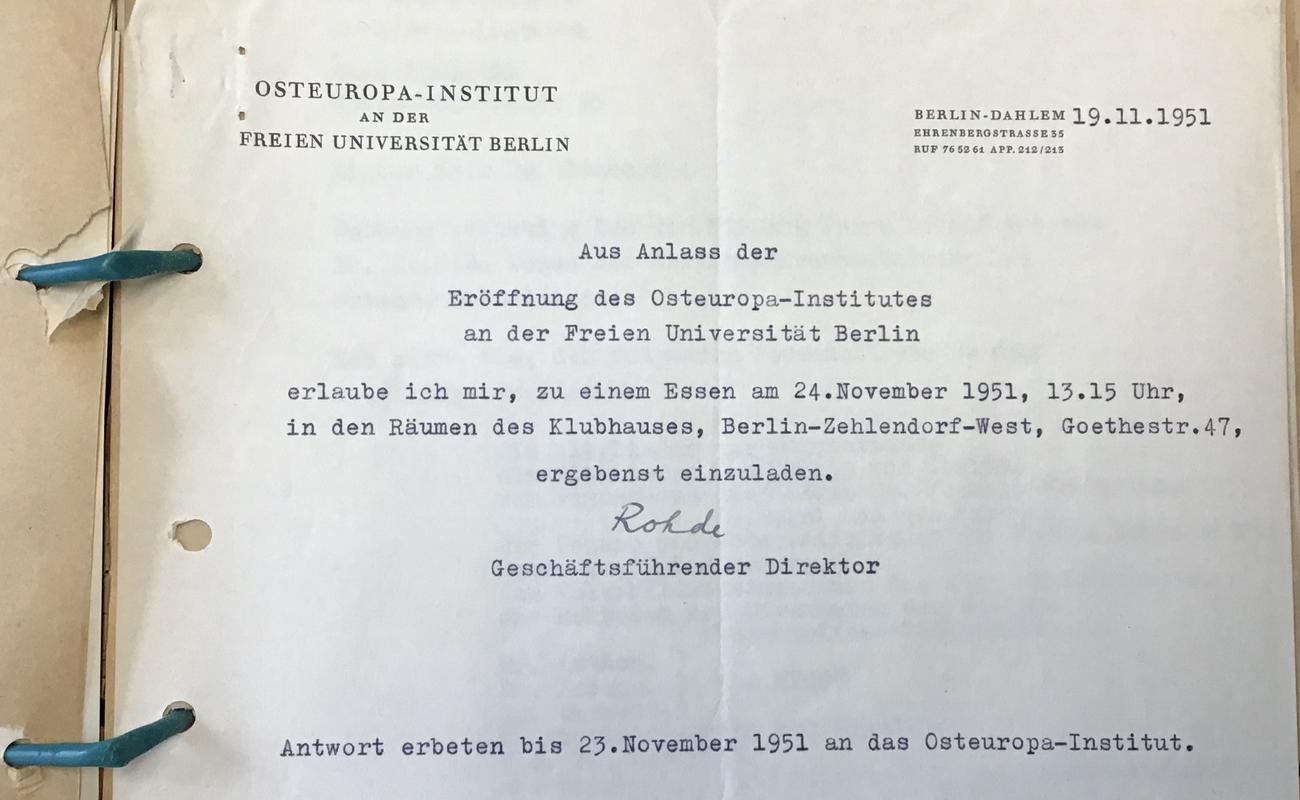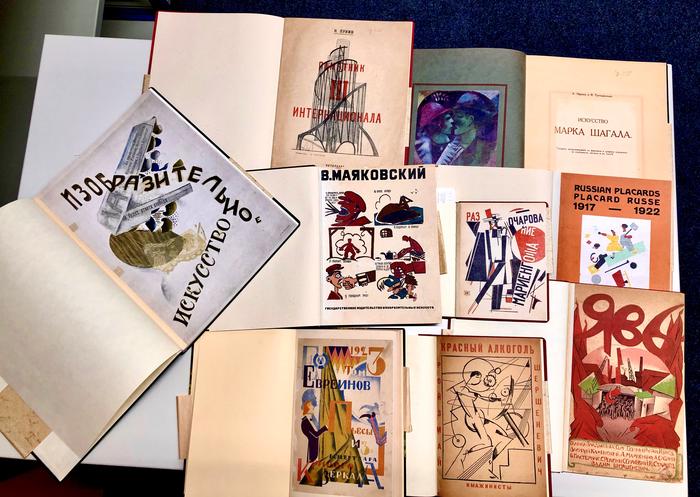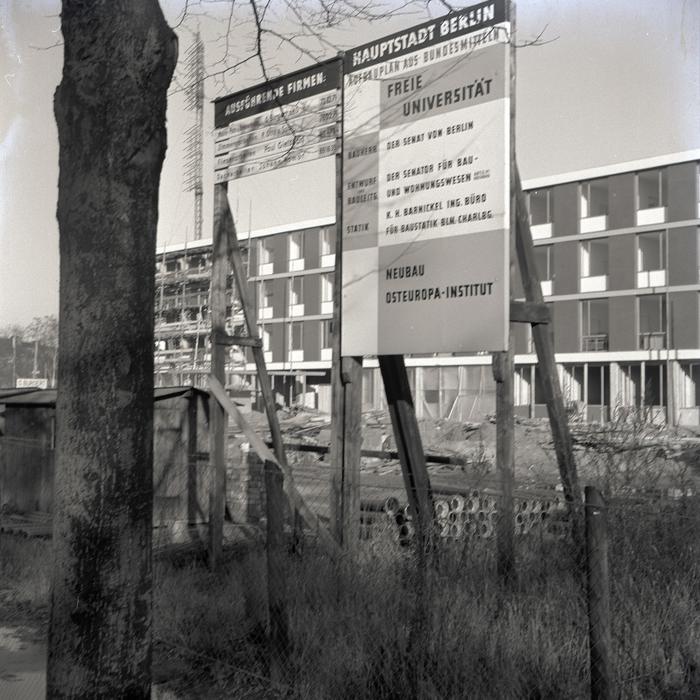70 years of OEI. A chronicle in pictures
Foundation of the Institute
The founding phase of the Institute for Eastern European Studies took place during the turbulent period of the reconstitution of Berlin's university landscape. Representatives of the federal government, the American occupation authorities, the city of Berlin, and Freie Universität, founded in 1948, were involved in the preparations. Georg Kennert, who later became the longtime administrative director of the Institute for East European Studies and was the personal assistant to the rector during the founding phase, already played a key role at this time. Max Vasmer (Slavic Studies) came to Freie Universität as early as 1949 and to the newly founded Osteuropa-Institut in 1951. Werner Philipp (History) moved from the University of Mainz to Freie Universität in 1951 and gave the ceremonial lecture at the founding act of the Osteuropa-Institut in 1951. Its research agenda was profoundly shaped by these two founding professors. Karl C. Thalheim (economics) and Walter Meder (law) were also among the founding professors.
Ehrenbergstraße 35
After the Second World War, research on Eastern Europe in Germany was initially discredited by the völkisch-oriented "Ostforschung". Ostforschung" was primarily devoted to "Germanness" in Eastern Europe and postulated its superiority over the Slavic population and the "Eastern Jews". During the Second World War, it then provided an apparently scientific foundation for the Nazi policy of extermination in the occupied eastern territories. Thus, after 1945, it was necessary to distance oneself from this "Ostforschung" and to develop new perspectives for research on Eastern Europe. These were to be oriented to the new realities of the Cold War. However, at the ceremony marking the founding of the Osteuropa-Institut on November 24, 1951, the governing mayor Ernst Reuter noted in his speech that an awareness also had to be created that the countries behind the Iron Curtain "belonged to Europe and that the Institute should contribute to forging a bond with the Eastern European peoples and point the way to a better future". The Institute for Eastern European Studies remains committed to this mission to this day.
The OEI Library
Fourteen Libraries Grow Together
At a time when free intellectual exchange in Eastern Europe could not be taken for granted everywhere, the foundation for the library of the Institute for Eastern European Studies was laid at Freie Universität. In 1951, the books of the Slavic Studies and Eastern European History departments moved into Ehrenbergstrasse 35 in Dahlem. The departments of Law and Economics also build up their own libraries. As the Institute grows, so do the book collections, until eventually 14 independently organized departmental libraries are established.
In 1989, the 14 departmental libraries became the "Library of the Institute of Eastern Europe". Here you can learn more about the Library of the Institute for East European Studies.
Book exchange 1952
Since its foundation, the OEI has strived for internationalization. In 1952, the OEI initiated a book exchange with the Westinstiut (Instytut Zachodni) in Poznań, which was located only 250 km to the east. This exchange started only 4 months after the opening of the OEI - at such an early stage that the OEI had no publications of its own that could have been sent to Poznań. In a letter to the West Institute, Georg Kennert explained that "our [the OEI's] publication program will not start until early summer".
OEI and the "Cold War": The Marxism-Leninism Project (1954-1964)
The Marxism-Leninism Project constituted an important milestone in the internationalization of the Institute for East European Studies and a significant research contribution. The project was carried out in close cooperation with U.S. researchers on Eastern Europe ("Russian Studies") and examined the ideational basis of Eastern European political and economic orders - Marxism-Leninism - and its distance from original Marxist thought. Herbert Marcuse, one of the most important protagonists of the project, put it this way: "In my view, there is still no adequate comprehensive critique of Marxism as an intellectual and political force, in its various ramifications and applications" (1957).
Garystraße 55
Photographer: Reinhard Friedrich / FU Berlin, UA, Foto-Sig. RF0049-01
Photographer: Reinhard Friedrich / FU Berlin, UA, Foto-Sig. RF0049-04
In 1959, financed by donations from the Ford and Rockefeller Foundations, construction begins on the new Eastern European Institute at Garystraße 55.
Photographer: Reinhard Friedrich / FU Berlin, UA, Foto-Slg., RF0000-85
Photographer: Reinhard Friedrich / FU Berlin, UA, Foto-Sig. RF0364-06
Together with the Otto Suhr Institute at Ihnestraße 21, the new Institute for Eastern Europe is planned by architect Werner Klenke as a cohesive ensemble of buildings.
1960s at the Institute for East European Studies
The 1960s were a time of upheaval in many respects: the protests against the Vietnam War, the anti-authoritarian movement, democratic awakenings in the East, the suppression of the Prague Spring. New ways of life were demanded and tried out. Students in Berlin were particularly active in this movement. Many well-known names are closely associated with FU Berlin.
This was also reflected at the Institute for East European Studies. However, the institute was not as central to the protests as the neighboring Otto Suhr Institute for Political Science. At the same time, the view of Eastern Europe changed. Only two years later, with the signing of the Warsaw Treaty, the Federal Republic recognized Germany's eastern border 25 years after the end of World War II. Willy Brandt's genuflection in Warsaw before the memorial in the former ghetto marked a new phase in the confrontation with German guilt.
Agreement with Saint Petersburg State University
A milestone in internationalization was the 1986 agreement with Shdanov University in Leningrad, now Saint Petersburg State University. The first to benefit at that time were Peter Jahn and Eckhard Matthes, both doctoral students at the OEI at the time. This agreement proved to be fruitful and was not only continued but continuously expanded over the years.
The last excursion to the Soviet Union
In July 1991 the last excursion of many to the Soviet Union took place. Twenty students from the Department of Scandinavian Studies and the OEI traveled for 14 days to Scandinavia and the USSR. The aim was to show starting points, obstacles as well as perspectives in multilateral cooperation. This took place shortly before the subsequent August coup d'état.
Graduate School 1991
The Institute for East European Studies intensively accompanied the processes of perestroika and the transformation period. In 1991, it established the DFG-funded Research Training Group "The Transformation of Social Systems in Eastern and Southeastern Europe since the 1980s and its Historical Preconditions". Until 1997, groundbreaking research on changes in social life worlds, historical consciousness, media and political systems was carried out here in an interdisciplinary perspective. Here you can access the bibliography of works produced within the framework of the Research Training Group on transformation in the 1990s (in German).
We have conducted interviews with former fellows of the Research Training Group about their time at OEI. You can find them here.
University secretariat through the ages
The 70th anniversary of the OEI is an occasion for staff in the secretariats to look back and recap how our work has changed over time.
What secretariats do today has little to do with the work of a secretary in the 1950s. As multitasking assistants with varied tasks and far greater responsibilities than before, it is hard to imagine university professors' anterooms without secretaries.
A brief overview of the development of secretarial work, not only at OEI, as well as interesting facts from everyday work can be read here.
The interviews with two former secretaries of the Institute for East European Studies provide vivid examples of the changes in the secretariats: the interview with Natalja Eisenblätter and the interview with Diana Nikolova.
A Child of the Cold War: Anniversary Exhibition
On Nov. 1, 2021, the exhibition "70 Years of OEI" opened with a commemorative event that ran until Nov. 30, 2021, in the Henry Ford Building. The exhibition threw light on the history of the Institute since its foundation in 1951.
On Sept. 24, 2021, an article about the exhibition was published in the current FU-Tagesspiegel supplement, in which curators Prof. Dr. Gertrud Pickhan and Dr. Alina Bothe and co-curator Tom-Aaron Aschke talk about the making of the exhibition. You can read the whole article here (in German).
















